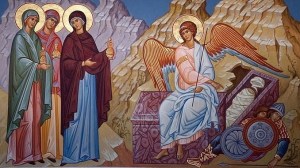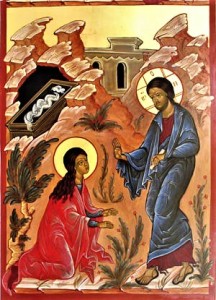Saint Mary Magdalene – Father Gavril Galev
 THE FIRST GOOD NEWS PREACHER (EVANGELIST) OF THE RESURRECTION
THE FIRST GOOD NEWS PREACHER (EVANGELIST) OF THE RESURRECTION
~+~
Some of you God has appointed in the Church: First apostles,
second prophets, third teachers; then He gave gifts of miracles and healings;
helpers, administrators and people who speak varieties of tongues.
(1 Cor. 12, 28)
Blessed Mary Magdalene received the gift to be “The Equal-to-the-Apostles”, because with her struggle she became like the apostles and became a preacher of the Gospel. She is called The Equal-to-the-Apostles, although apostleship as a priesthood activity in the Church is a gift for men, but her name is mentioned in the Scriptures many more times than the names of some of the apostles.
The fact that there is neither male nor female, but all are one before Him, and everything depends on our personal relationship with Him, testifies Mary Magdalene – The Equal-to-the-Apostles. Perhaps, not many women are found in the diptych (list) of the Orthodox Church, but those who are glorified have attained such great holiness and glory that they are even ahead of men. In accordance with the words of St. John Chrysostom: “Women are capable of great deeds, even greater than those of men.” One of them is the Holy Myrrh-Bearer Mary Magdalene.
Although the respect for her is very high, there is not much information about her. Some confuse her with the harlot in Simon’s house, the one who washed Chris’s feet with tears and anointed His head with ointment. Some consider her to be Mary, the sister of the resurrected Lazarus of Bethany. However, the Myrrh-Bearer Mary is none of them. These are three different women and there is no connection between them.
In the Holy Scriptures several Marys a mentioned. Mary was a name that was quite popular at that time. Mary Magdalene, of whom we are writing now, is mentioned by the evangelists Mark and Luke. It is said that Christ cast out seven demons from her and completely healed her from the disease she was suffering from. According to the evangelists, the name Mary Magdalene differs from other women who bear the name Mary, because next to the first name stands the name “Magdalena” or “Magdalina”, which in Aramaic means “tower” or something wonderful, great, or majestic.
She comes from the region of Magdala, a small town on the west coast of Lake Gennesaret, which is why she is called Mary Magdalene, from the tribe of Isaac. The Gospel of Luke lists her as one of the women who travelled with Christ and “served Him with their possessions,” indicating that she probably came from a wealthy family.
 THEIR FAITH WAS STRONGER THAN THE FAITH OF THE DISCIPLES OF CHRIST
THEIR FAITH WAS STRONGER THAN THE FAITH OF THE DISCIPLES OF CHRIST
Let men support women and may they
not forget Christ in the temptations.
– Saint John Chrysostom
St. Mary Magdalene is one of the Myrrh-Bearing women, together with the Mother of God (Bogorodica), the first and supreme Myrrh-Bearer, then Salome, Mary, the mother of John, Mary Cleopas, Joanna, Susanna and Mary, the mother of James. St. Mary Magdalene, along with the other Myrrh-Bearing women, remained faithful to Christ even in the most difficult moments, thus showing their true faith, love, and devotion to Him, as one should do towards God and Saviour.
While all the apostles, except St. John the Theologian, fled from under the Cross, they stood fearlessly and watched where they would lay the body of Jesus in order to take It and prepare It for burial in accordance to the Jewish law. “Under the cross of Jesus stood His mother and His mother’s sister, Mary Cleopas and Mary Magdalene” (John 19:25). Their love was greater than their fear and they completely overlooked the possibility of any danger. As St. John Chrysostom says: “Women stood under the Cross, and the weaker gender emerged more mannish.” After Christ was taken down from the Cross, they went to the tomb where He was laid, so that they could anoint Him with myrrh, in accordance to the Jewish custom.
 Because the Crucifixion took place on Friday night, and on Saturday no one works and no one leaves the house, according to the Jewish custom, spending the whole day in mourning, after the Sabbath (Saturday) had passed, the Myrrh-Bearing women went to the tomb early in the morning. They came to the tomb before anyone else, before dawn. Mary Magdalene came before all, and St. John Chrysostom lets us know why: “Completely filled with love for her Teacher, when Sabbath was over, she could not wait any longer, so she came to the tomb early in the morning, wanting somehow to be comforted.”
Because the Crucifixion took place on Friday night, and on Saturday no one works and no one leaves the house, according to the Jewish custom, spending the whole day in mourning, after the Sabbath (Saturday) had passed, the Myrrh-Bearing women went to the tomb early in the morning. They came to the tomb before anyone else, before dawn. Mary Magdalene came before all, and St. John Chrysostom lets us know why: “Completely filled with love for her Teacher, when Sabbath was over, she could not wait any longer, so she came to the tomb early in the morning, wanting somehow to be comforted.”
 LIFE-GIVING FRAGRANCE FOR LIFE
LIFE-GIVING FRAGRANCE FOR LIFE
“Rejoice!”
(Matthew 28: 9)
The Holy Apostle and Evangelist John writes: “On the first day of the week, very early, while it was still dark, Mary Magdalene came to the tomb and saw that the stone had been taken away from the tomb” (John 20: 1). When St. Mary Magdalene arrived, she found the tomb empty. To her great surprise, she saw that the stone had been moved and the tomb was empty. Astounded, Mary Magdalene hastily went to the apostles John and Peter and said, “They have taken away the Lord out of the tomb, and I do not know where they have laid Him” (John 20: 2). John and Peter immediately followed her, and when they entered the cave, they saw that the body was gone and that only the linen cloths with which it was wrapped were in the corner.
They went away to their own homes, “but Mary stood outside by the tomb weeping.” “The men went away, but the weaker gender was tied to that place with greater love,” said Blessed Augustine. “And as she wept, she stooped down and looked into the grave; And she saw two angels in white clothes sitting, one at the head, and the other at the feet, where the body of Jesus had lain. Then they said to her, Woman, why are you weeping? She said to them, “Because they have taken away my Lord, and I do not know where they have laid Him.” Now when she had said this, she turned around and saw Jesus standing there, and did not know that it was Jesus. Jesus said to her, “Woman, why are you weeping? Whom are you seeking? ‘She, supposing Him to be the gardener, said to Him,’ Sir, if You have carried Him away, tell me where You have laid Him, and I will take Him away. ‘ Jesus said to her, “Mary!” She turned and said to Him, “Rabboni,” (which is to say “Teacher!”). Jesus said to her, “Do not cling to Me, for I have not yet ascended to My Father; But go to My brethren, and say to them, I am ascending to My Father, and your Father, and to My God, and your God. Mary Magdalene came and told the disciples that she had seen the Lord and that He had spoken these things to her ”(John 20: 11-18).
At that time to the other Myrrh-Bearing women, who were on the road, returning from the tomb, the Risen Jesus Christ appeared, and said to them, “Rejoice!” They fell at His feet and worshiped Him. Because of their fearless love and faithfulness, the holy women who zealously served the Lord throughout their lives were the first to see Him Resurrected and to be the first heralds of His glorious Resurrection.
Sometime in the past, it was the woman who sinned first, and after that the man; now, however, the woman was the first to receive the news of the Resurrection. Through the woman, sorrow came into the world, and now, through her – the joy of the Resurrection. She could not hide the salvific (salvation) joy of seeing the Risen Lord and she was the first to go to His disciples to comfort them with the joyful words: Christ is Risen! As the first evangelist of the Resurrection, she is recognised by the Church as the one equal to the apostles, as an “apostle of the apostles.”
The Holy Tradition says that the Risen Christ, as a humble and obedient Son, appeared first to His Mother and then to Mary Magdalene. “Indeed, who is standing at the head of all Myrrh-Bearing Women?” Who is the one that gives the Myrrh-Bearing Women all the glory of heaven? – The Most Holy Mother of God (Bogorodica). She – She is the supreme and the First Myrrh-Bearing Woman. In the holy prayers it is said of Her – She gave birth to the Myrrh-Scent of Heaven, the Lord Christ, the Fragrance. That is why she is the First Myrrh-Bearer, above all others. ”
 THE FRAGRANCE OF CHRIST BEFORE GOD
THE FRAGRANCE OF CHRIST BEFORE GOD
After the Ascension of the Lord, she travelled through many lands, preaching about Christ, the same as the holy apostles. First, immediately after these events, she arrived in Rome and offered an egg to the Emperor Tiberius, addressing him with the words: Christ is Risen, and thus she announced to him about the Crucifixion and the Resurrection of Christ. She also accused Pontius Pilate that, although he could, he did not protect the Righteous Jesus, but was afraid of the Jews and he only washed his hands, pretending to be innocent. That was the reason why the emperor withdrew Pilate from Jerusalem and sent him, as a punishment, to a service in the Alps, where he ended his life in imperial disfavour (mercilessness)
According to Holy Tradition, when Mary began to speak to Tiberius about the Resurrection of Christ, the emperor laughed, saying, “This is not possible, as it is impossible for your white egg to turn red.” He had not yet finished the sentence, and the egg in Mary Magdalene’s hands had turned red.
Later Mary Magdalene came to Ephesus, where she assisted St. John the Theologian in the preaching of the Gospel. There she reposed and was buried in the same cave, where later the Holy Seven Youth of Ephesus miraculously slept for hundreds of years, and then woke up and fell asleep again, and by God’s providence, they bore witness of the Resurrection.
In the 9th century, her incorruptible relics were solemnly carried by the emperor Leo IV the Wise (886-912) to Constantinople and laid in the temple at the monastery dedicated to St. Lazarus, performing many miracles in the glory of Christ our God.
Part of the relics of St. Mary Magdalene – “The Equal-to-the-Apostles ” are kept in the Holy Mountain’s monastery Simonopetra, that is, her left hand, which is incorruptible and fragrant, and warm as of a living person.
The Holy Church of Christ celebrates her remembrance on the 4th of August according to the new, i.e. on the 22nd of July according to the old calendar, as well as in the third week after Easter, when the Holy Myrrh-Bearing women are celebrated.
Through her holy prayers, Lord Jesus Christ, have mercy on us!
Prepared by: Father Gavril Galev
Abbot of the monastery “St. Clement of Ohrid”,
Kinglake, Melbourne, Australia
5 / 08 / 2020
